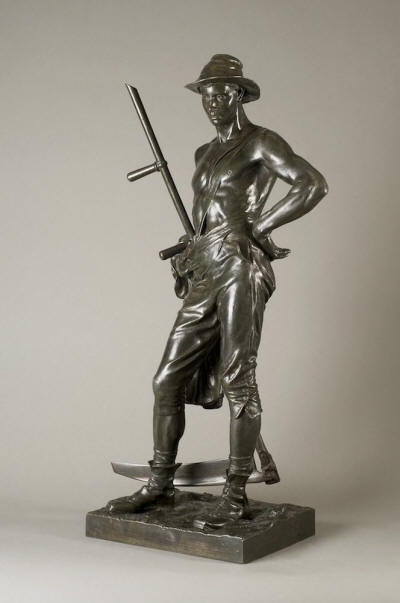

Queer Places:
2b Melbury Rd, Kensington, London W14 8LP, UK
Wolvercote Cemetery
Oxford, City of Oxford, Oxfordshire, England
 Sir
William Hamo Thornycroft
RA (9 March 1850 – 18 December 1925) was an English
sculptor,
responsible for some of London’s best-known statues. He was a keen student of
classical sculpture and became one of the youngest members of the
Royal Academy.
Sir
William Hamo Thornycroft
RA (9 March 1850 – 18 December 1925) was an English
sculptor,
responsible for some of London’s best-known statues. He was a keen student of
classical sculpture and became one of the youngest members of the
Royal Academy.
He was the leading figure in the movement known as the New Sculpture, which provided a transition between the neoclassical styles of the 19th century and its later fin-de-siècle and modernist departures.
Hamo Thornycroft belonged to the Thornycroft family of sculptors. His father, Thomas, mother Mary, and grandfather John Francis were all distinguished sculptors. He was born in London. His brother, Sir John Isaac Thornycroft, became a successful naval engineer; their sister, Theresa, was the mother of the poet Siegfried Sassoon; Theresa and sisters Alyce and Helen Thornycroft were artists. Hamo's early training was with his parents and he developed a passionate and precocious attachment to Classical sculpture. He subsequently studied at the Royal Academy of Arts, where his primary influence was the painter-sculptor Frederic Leighton. Hamo won the Gold Medal of the Royal Academy in 1876, with the statue Warrior Bearing a Wounded Youth.
He was the leading figure in the movement known as the New Sculpture.[1] His close personal friend, the critic Edmund Gosse, coined the term "The New Sculpture" in 1894 and formulated its early principles from his relationship with Thornycroft. Thornycroft created a series of statues in the ideal genre in the late 1870s and early 1880s that sought to reanimate the format of the classical statue. These included Lot's Wife (1878), Artemis and her Hound (1880 plaster, 1882 marble), the Homeric bowman Teucer (1881 plaster, 1882 bronze), and the Mower (1884 plaster, 1894 bronze), arguably the first life-size freestanding statue of a contemporary laborer in 19th-century sculpture.

The Mower, 1888-1890
The Mower was based on a sketch made during a summer boat trip along the Thames with a group of friends in 1882. The party included Edmund Gosse who, as Michael Hatt has argued, was deeply in love with Thornycroft and sent him passionate letters and poems that went "beyond conventions of the expression of friendship, even by Victorian standards."
In 1884 he married Agatha Cox, who was fourteen years his junior. At a dinner in 1889, Agatha was introduced to Thomas Hardy, who later described her as "the most beautiful woman in England" and admitted that she was one of the models for the title character in his novel Tess of the D'Urbervilles.[2] Agatha and her husband were interested in the concept of "artistic dress", and a dress worn by her (presumed to be her wedding dress) is held in the costume collection of the Victoria & Albert Museum, donated by their daughter.[3]
Thornycroft was one of the youngest artists to be elected to the Royal Academy, in 1882, the same year the bronze cast of Teucer was purchased for the British nation under the auspices of the Chantrey Bequest. After 1884, Thornycroft's reputation was secure and he received commissions for a number of major monuments, most notably the innovative General Gordon. Thornycroft continued to be a central member of the sculptural establishment and the Royal Academy into the 20th century. He was knighted in 1917. He became increasingly resistant to new developments in sculpture, although his work of the early 1880s helped to catalyze sculpture in the United Kingdom towards those new directions. In sum, he provided an important transition between the neoclassical and academic styles of the 19th century and its fin-de-siècle and modernist departures.
A blue plaque commemorates Thornycroft at 2b Melbury Road, Kensington,[4] his studio designed by lifelong friend John Belcher, c. 1892.[5][6]
My published books:
https://en.wikipedia.org/wiki/Hamo_Thornycroft